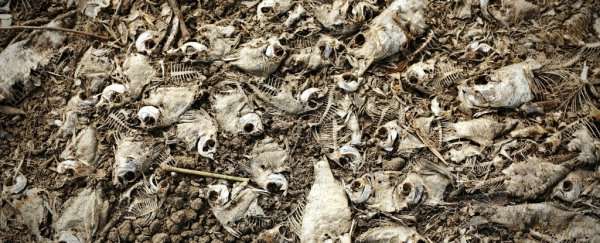The 'simpler' diet of palaeolithic humans has been romanticised into a health fad, but new research indicates our ancestors weren't necessarily enjoying the pinnacle of food sources. In fact, they may have been consuming unhealthy levels of toxic heavy metals.
In Norway, between 6,300 and 3,800 years ago (a little bit later than the true Palaeolithic), at a time known as the Younger Stone Age, the seafood that dominated most of the local diet seems to have contained dangerous levels of lead and cadmium, a new study shows.
And it's not just a relic of the past. Those elevated levels of heavy metals, the researchers said, could be linked to a changing climate that followed the last ice age, which ended around 11,700 years ago.
As the climate continues to change at an unprecedented rate, these findings indicate we too could start to see higher levels of heavy metal contaminants in some of our food supply.
"The elevated values may have been detrimental for humans, if not for society; a balancing factor may have been a larger component of terrestrial resources than previously assumed," the researchers wrote in their paper.
"Concomitantly, this contribution to the paleo base-line record of toxicity may lead to predictions for seafood contamination in the future."
There were no actual human remains available from this time period, so researchers from The University of Tromsø - The Arctic University of Norway went for the next best thing: fossilised garbage.
Yep, that's correct. We humans are just garbage-making machines. And those crime procedural telly shows are right about one thing - you can tell a lot about people from what they throw away. In the case of the Younger Stone Age people, their garbage heaps - known as middens - contain the remains of what they ate.
The middens were filled with seafood bones, so that's what the researchers studied. From household food waste piles at eight archaeological sites, they collected the bones of Atlantic cod (Gadus morhua) and harp seal (Phoca groenlandica).
These were carefully cleaned and drilled into a fine bone powder; from this powder, the researchers could extract the collagen needed for stable isotope and elemental analyses. Of the 124 bones (76 cod, 48 seal) sampled, only 40 (16 cod, 24 seal) produced enough good quality collagen for analysis.
But these analyses revealed shockingly high levels of cadmium and lead.
"On average, the levels of cadmium and lead contamination in cod were up to 22 and 3 to 4 times, respectively, higher than today's recommended limits in soft tissue. The corresponding figures for seal were 15 and 3 to 4 times, respectively," the researchers wrote.
According to the European Food Safety Authority, the recommended safe soft tissue limits for cadmium and lead are, respectively, 50 nanograms per gram and 300 nanograms per gram.
The team also measured the mercury levels in the bones and found that, although they were within modern safe limits, they were also noticeably high.
Cadmium occurs naturally in soil, and accumulates in the body over time, especially in the liver and kidneys. It can cause cancer, as well as diseases in the kidneys, liver and lungs, and has also been linked to osteoporosis.
Lead also occurs naturally in soil, and accumulates in the human skeleton over time. It can negatively affect the brain and nervous system. Finally, mercury can enter the food chain when it becomes methylated, which occurs in aquatic systems as the result of microbial activity. It can cause significant neurological and immune problems.
"We have used cod and seals as proxies for understanding how the load of these heavy metals might have been on the contemporary human population in the area," the researchers wrote in their paper. "Marine food during the Younger Stone Age in Varanger was unhealthy if not unsafe."
There is still a lot the team didn't manage to ascertain. For example, rising sea levels - a symptom of a warming climate - were positively correlated with the higher levels of heavy metals in cod, but there was no correlation with rising sea surface temperature. So there could have been other factors at play, or a delayed response.
It's also possible that the detrimental effects of heavy metals in the seafood component of the Norwegian Younger Stone Age diet were mitigated by other components - venison and hare, and waterfowl, whose bones were also found in the middens, for example.
To understand how prehistoric hunter-gatherer health, economies and culture were potentially affected by ingesting heavy metals, the researchers note in the paper that "further studies from the entire Holocene, at both regional and circumpolar scales are warranted."
Who knows what else lies in those ancient garbage piles - but it doesn't look like a recipe for a truly healthy diet.
The research has been published in Quaternary International.
